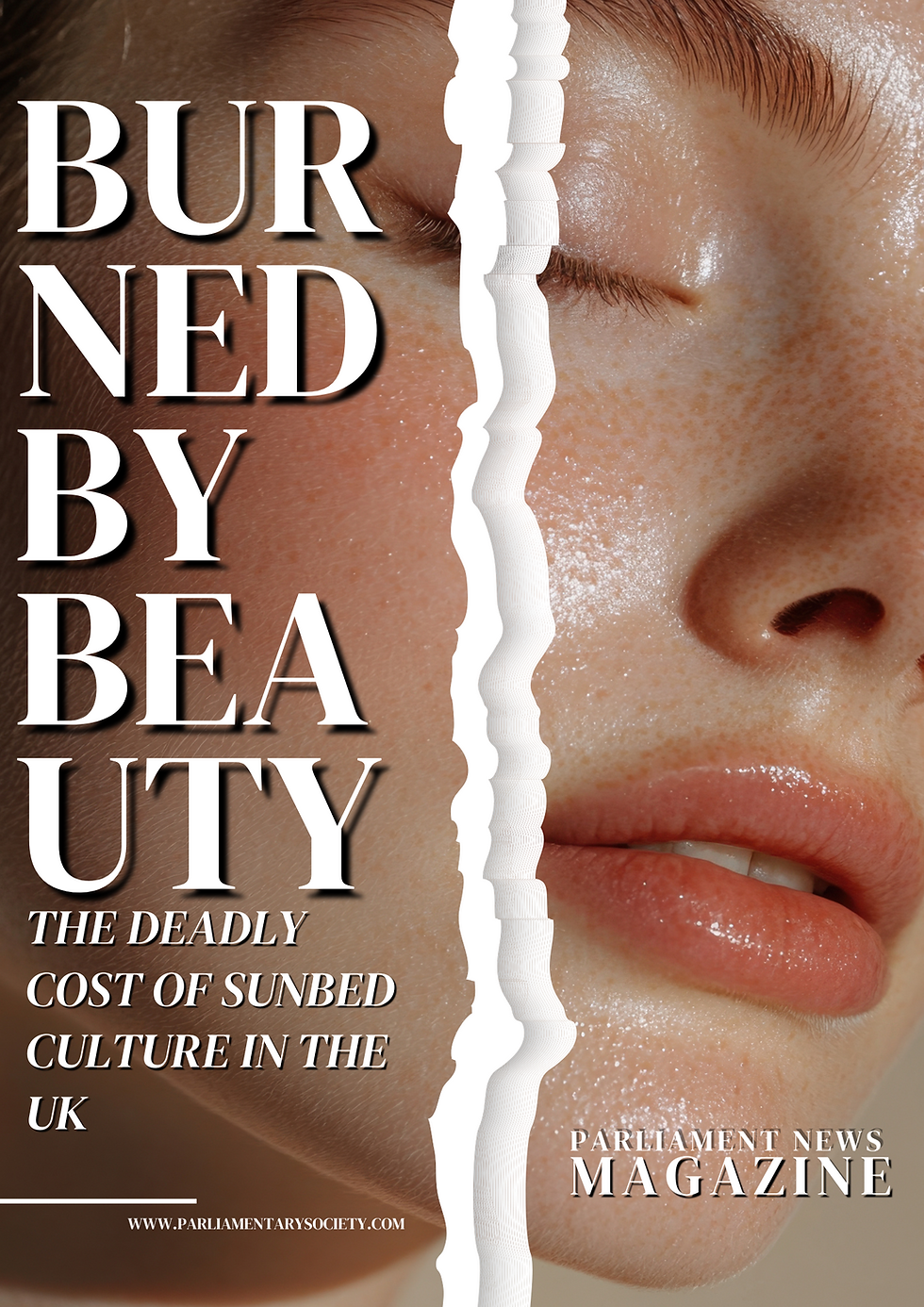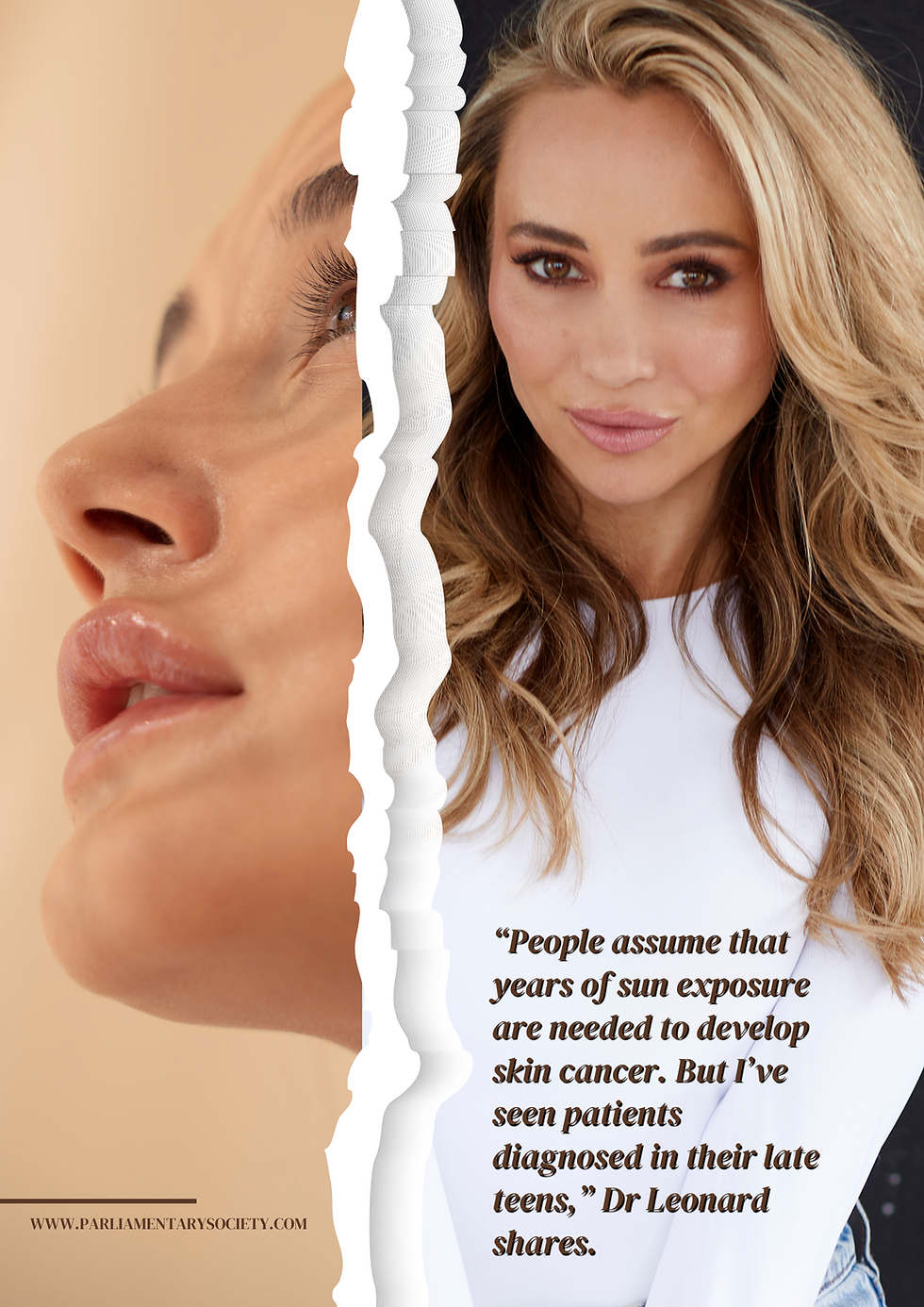“BURNED BY BEAUTY: THE DEADLY COST OF SUNBED CULTURE IN THE UK”Featuring expert commentary from Dr Jane Leonard, GP and Skin Specialist
- PARLIAMENT NEWS

- Aug 7
- 6 min read
Parliament News Press

The Allure of a Tan—and the Invisible Scars
In the United Kingdom, where sunlight is often more myth than meteorological reality, the quest for bronzed skin has taken a perilous turn. With over a quarter of British adults admitting to using sunbeds—and 43% of 18–25 year olds engaging in this practice regularly—the so-called “healthy glow” has become a deadly illusion.
What was once a symbol of leisure and luxury now casts a darker shadow. The tanning industry continues to thrive despite mounting medical evidence, public health warnings, and the tragic stories of young lives devastated by skin cancer. A recent study by Melanoma Focus revealed that the use of sunbeds in cities such as Belfast has reached staggering levels—over 37% of adults there are regular users, earning it the dubious title of “sunbed capital of the UK.”
Behind this cosmetic culture lies a public health emergency—and at the forefront of calling it out is Dr Jane Leonard.

A Doctor’s Warning: The Silent Epidemic of UV Damage
Dr Jane Leonard, a highly regarded GP and skin specialist, has spent her career championing skin health and wellness. Founder of the Dr Jane Leonard Clinic in London, she blends medical expertise with a compassionate, patient-centred approach to skincare. Yet despite the advanced treatments and rejuvenating care she provides in her clinic, one conversation continues to haunt her: sunbed use.
“Sunbeds are a major public health concern,” Dr Leonard begins. “The risks are well established, especially when it comes to skin cancer. Using sunbeds before the age of 35 can increase the risk of melanoma by nearly 60%.”
But melanoma isn’t the only concern. Sunbeds also significantly raise the likelihood of developing other types of skin cancer, such as basal cell carcinoma and squamous cell carcinoma. According to Cancer Research UK, the high-intensity ultraviolet (UV) radiation emitted by sunbeds damages the DNA in our skin cells—damage which may be invisible for years before manifesting as cancerous mutations.

“Each use of a sunbed is a step closer to irreversible damage,” Dr Leonard says. “There is no such thing as a safe UV tan.”
From Vanity to Vulnerability: The Physical Toll
The misconception that indoor tanning is somehow safer than sunbathing is not only inaccurate—it’s dangerous. The radiation level from commercial sunbeds in the UK is legally capped at 11 standard erythema doses (SEDs) per hour, equivalent to lying under the tropical sun at high noon. And yet, that remains an accepted legal limit for voluntary exposure in salons.
UV exposure doesn’t just increase cancer risk—it accelerates ageing. “Sunbeds break down collagen and elastin, leading to premature wrinkles, leathery skin, and pigmentation issues,” Dr Leonard explains. “It’s a cosmetic irony—people use sunbeds to look better, but they’re actually accelerating the very signs of ageing they’re trying to prevent.”
Eye health is another neglected risk. Without the correct eye protection, users risk cataracts, retinal damage, and even corneal burns. Long-term exposure can cause permanent vision impairment.
And perhaps most alarmingly, excessive UV radiation can suppress the skin’s immune function. “This means the skin becomes less able to detect and respond to abnormalities,” Dr Leonard notes. “In essence, you’re compromising your body’s natural cancer defence system.”
The Misleading Vitamin D Myth
One of the more persistent justifications for sunbed use is the claim that it helps the body produce vitamin D—an argument that, while seductive, doesn’t hold up to scientific scrutiny.
“The vitamin D argument is a red herring,” Dr Leonard says plainly. “The damage caused by UV exposure far outweighs any marginal vitamin D benefit. In the UK, supplements during winter months are the recommended approach.”
As reinforced by both the NHS and the UK Health Security Agency, 10 micrograms of vitamin D per day is enough. There is no need to resort to harmful radiation.
Tanning and the Teen Brain: Addiction, Image, and Influence
The attraction of sunbeds is no longer just a matter of aesthetics; it’s psychological. “Tanning addiction is real,” Dr Leonard warns. “It’s often tied to poor body image and low self-esteem, especially in teenagers and young adults.”
Social media exacerbates this issue by glorifying tanned skin as a beauty standard—a phenomenon particularly prevalent among influencers and reality TV stars. The pressure to conform can lead to compulsive tanning behaviours, with users feeling anxious or unwell when their skin appears too pale.
“Much like disordered eating, tanning can become a form of control and a response to societal pressures,” says Dr Leonard. “It’s important to recognise this as a mental health concern, not just a cosmetic choice.”

A Grim Reality: The Rise of Melanoma
Melanoma is now the most common cancer in women in their 20s—an alarming fact that contradicts the long-held belief that skin cancer primarily affects the elderly. “People assume that years of sun exposure are needed to develop skin cancer. But I’ve seen patients diagnosed in their late teens,” Dr Leonard shares.
One such case is Georgia Edwards, diagnosed with melanoma at just 19 after regular sunbed use from the age of 17. Now 26, she remains under medical observation for any sign of recurrence.
Her story is not unique. In the UK, approximately 440 melanomas and 100 deaths every year are directly linked to sunbed use. And with sunbed usage remaining popular among young adults, these figures are likely to rise.

Legal Loopholes and Lack of Regulation
Despite the clear evidence, sunbeds remain widely available across the UK. Under the Sunbeds (Regulation) Act 2010, it is illegal for businesses to offer sunbeds to anyone under the age of 18. However, there is no national licensing system or requirement for trained supervision in salons.
“There’s no real regulation around who can open or operate a tanning salon,” Dr Leonard stresses. “This leaves users—especially young, impressionable people—vulnerable to unqualified advice and unsafe practices.”
By contrast, countries like Brazil and Australia have implemented full bans on cosmetic sunbed use. Many health experts, including Dr Leonard, believe the UK should follow suit. “A full ban is, in my view, the only meaningful way to reduce the damage sunbeds cause,” she asserts.
The Rise of Unregulated Enhancers: A Toxic Cocktail
Adding further danger to the mix is the growing market of unregulated tanning products—nasal sprays, injections, gummies, and accelerators—often promoted on social media. These products promise faster, darker tans and are marketed directly to sunbed users.
Melanotan II, a synthetic hormone often sold as a “tan jab” or nasal spray, is illegal to sell in the UK. Yet it is widely accessible online and frequently used alongside sunbeds. The side effects? Nausea, vomiting, increased sensitivity to sunburn, irregular heart rhythms—and a complete lack of clinical safety testing.
“The problem is, these products are marketed as safe ‘shortcuts’ to a tan,” Dr Leonard explains. “They’re not. They’re unregulated, unproven, and in many cases, harmful.”
What the Public Needs to Know
Key facts every UK citizen should understand:
UV tanning is not safe. There is no such thing as a “safe tan” from sunbeds.
Tanning damages DNA, accelerating skin ageing and dramatically increasing cancer risk.
Vitamin D can be obtained safely through diet and supplements.
Tanning addiction is real, and it is often rooted in poor mental health.
Sunbed use is linked to around 100 deaths per year in the UK alone.
Young people are especially vulnerable, with risks compounded by social media misinformation.
A Safer Path: Embracing Natural Skin and Fake Tan Alternatives
The safest way to achieve a bronzed glow is through fake tan products. Spray tans and bottled self-tanners contain dihydroxyacetone (DHA), which reacts with the outermost layer of the skin to create a temporary colour change. These products are tightly regulated in the UK and pose no known cancer risk.
“Fake tan is the only safe tan,” says Dr Leonard. “It offers the aesthetic result without the devastating long-term consequences.”
Final Thoughts from Dr Jane Leonard “For every person who walks into my clinic looking for rejuvenation, I want to offer more than just treatment—I want to offer education. If there’s one thing I’d ask readers to take away, it’s this: every single sunbed session leaves a permanent mark. Skin cancer is not just an ‘older person’s disease’. It can strike young. And often, it does.”
Call to Action
The UK must face the reality of its tanning culture. Public awareness campaigns, policy reform, and above all, cultural change are needed. With professionals like Dr Jane Leonard leading the charge, we may yet turn the tide on one of Britain’s most preventable health crises.
Because no tan is worth your life.
For more information or skin health support, contact:
Dr Jane Leonard Clinic
Website: https://www.drjaneleonard.co.uk/
Instagram: @drjaneleonard






Comments